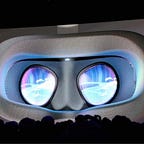VR AR Judder is Visible Latency
When your graphics jiggle, or strobe, blur or judder, in your VR /AR headset, that’s visible latency, and high persistence.
One of the limitations keeping companies from fixing this is the hz your screen runs at.
One of the modern innovations that led to comfortable Virtual Reality was created by Valve and borrowed by the Oculus team before Facebook purchased them. Reference this article for that story:
That is the realization that a technique called Low Persistence could be applied to hide the inadequate latency of current screen technology. Today even with 90hz headsets that you can see on the Oculus Rift and the HTC Vive consumer versions you can still see judder, you can see it when the 3D object you are looking at seems to vibrate a tiny amount, or when you move around in VR really fast and start to see the hint of motion blur, and start feel motion sickness, which is when your forehead starts to sweat, your body starts to heat up like you are sick, a headache might form, you might get nausea, the symptoms of motion sickness are many and varied and some people might not have any symptoms that they are able notice right away.
To go really in depth on this topic read this:
In all the current generation VR and AR headsets the graphics jiggle just a tiny amount. That jiggle is visible latency, it is a major contributor to headaches, motion sickness, excessive sweating, and even nausea.
As a side note, the Playstation VR might have the least amount of judder in the current generation of VR headsets, that includes the Rift and the Vive. This is because it combines a 120 hz headset, with low latency technology, with low persistence screen drivers, but to be honest I am already looking forward to the next generation of VR headsets that have displays featuring 1,700 hz, with zero latency, where the objects appear extremely solid no matter how fast you move around in VR.
Read a story about why Playstation VR is Virtual Realities Trojan Horse.
So I was really excited to learn about that there is a solution to all of that judder caused by the latency of current hz screens and its coming from Nvidia. It’s a display that runs at 1,700 hz, currently the lowest latency VR headset is the Playstation VR which runs at 120 hz (and 120 frames per second) and that has the least amount of visible jiggle on 3D objects (visible latency) so far but Nvidia is showing the world that we can do much better than this.
This means that the next generation of VR and AR headsets will be much more comfortable to wear, people will like them more, and wear them longer.
I was at GTC 2016 when the news broke and I was going to write an article about this but RoadtoVR beat me to it. It’s a really excellent article by Ben Lang so I hope you check it out.
See the original story at Road to VR
I am a researcher, business analyst, consultant, and I write about neuroscience, deep learning, virtual reality, and related technologies. My website is http://vrma.work
I post a lot in these VR & AR groups:
Gear VR 10,086 Members https://www.facebook.com/groups/gearvr/
Oculus Rift 10,844 Members https://www.facebook.com/groups/oculuscreative/
Virtual Reality 13,364 Members https://www.facebook.com/groups/virtualrealitys/
The Matrix 60,004 Members https://www.facebook.com/groups/The.Matrix.of.Knowledge/
Women in VR 1,615 Members https://www.facebook.com/groups/womeninvr/
